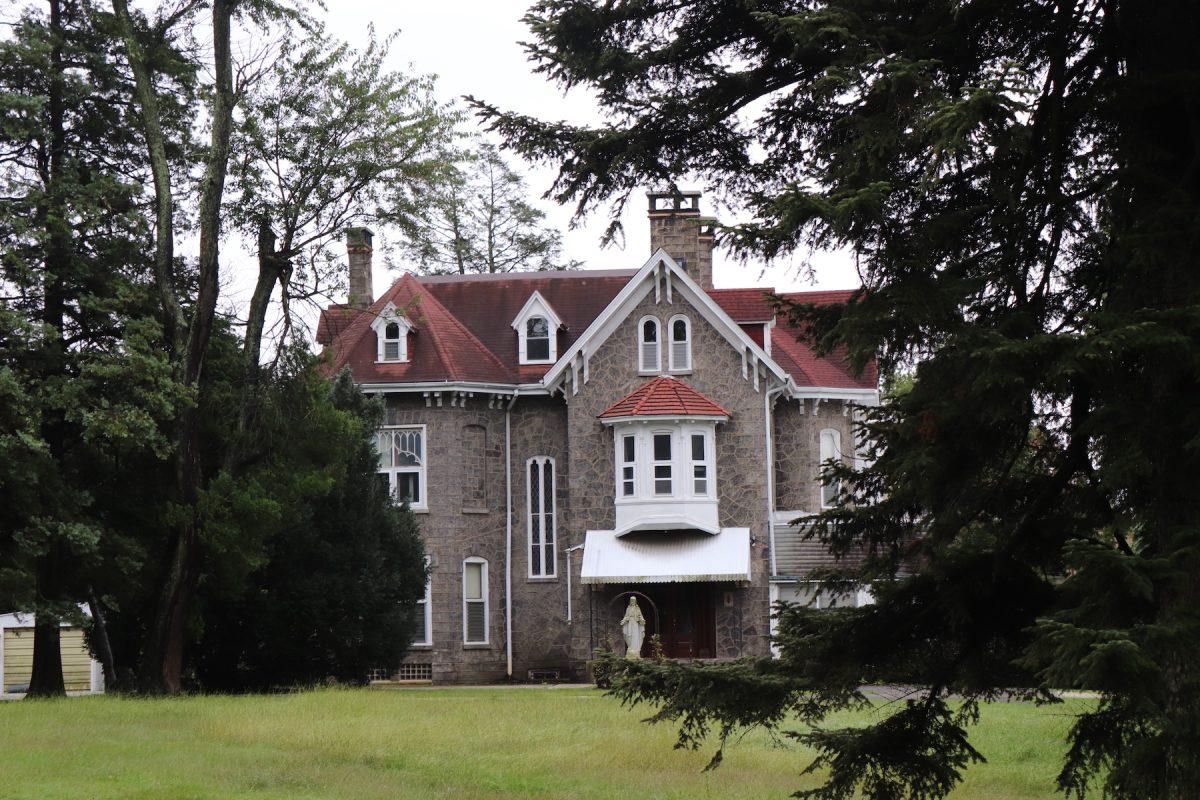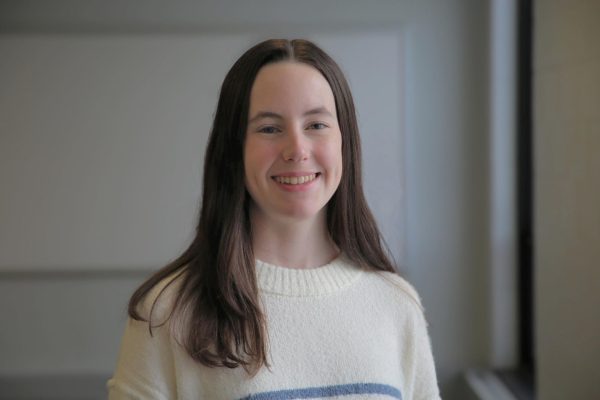Moving out of the Sisters of the Visitation Monastery of Philadelphia was a faith-filled experience as well as a painful goodbye for Sister Catherine Therese, VHM.
“It was more than just a building,” Sister Catherine said. “So much of our lives are spent in the monastery and on the grounds, almost completely, our whole lives. To celebrate the last mass and put out the sanctuary light and dismantle everything, it was hard.”
The monastery sits on an 11.6 acre property on City Avenue between Hawk Hill’s Wolfington Welcome Center and the Morris Quad Townhouses. St. Joe’s purchased the property for $15 million June 27, according to the deed records from the Philadelphia Department of Records. For 83 years, it had been home to the Sisters of the Visitation of Philadelphia, a group of cloistered nuns who have limited contact with the outside world and spend their days dedicated to prayer, faith and community with each other and with God.
The property provides the Hawk Hill campus with a “contiguous frontage along City Avenue,” wrote Kevin Mueller, MBA ’22, senior director of construction and planning, in response to written questions from The Hawk.
“Right now, it is undecided how the university will use this newly-acquired parcel of land,” Mueller wrote. “However, we are considering a direct pedestrian corridor from the center of the Hawk Hill campus to the residence halls of Moore Hall, the Morris Townhouses and Ashwood Hall.”
The Visitation Monastery of Philadelphia is part of the Order of the Visitation of Holy Mary, which was founded in 1610 by St. Jane Frances de Chantal and St. Francis de Sales in Annecy, Haute-Savoie, France. The Order eventually spread throughout Europe and North America.
The sisters have resided in Philadelphia for 97 years and have history across the United States. Sisters from Alabama founded a monastery in Mexico City, but in 1926, both American and Mexican sisters from the Mexico City monastery were forced to flee to the U.S. due to religious persecution. They made their way to Camac Street in Philadelphia later that year, and moved to the location on City Avenue in 1940. Over the years, the sisters added areas to the main house, including a chapel in 1958 and an infirmary a few years later.
St. Joe’s was a clear choice of buyer due to its “long-standing relationship” with the sisters, Mueller wrote. Last year, the sisters hosted their annual Novena of the Sacred Heart of Jesus, a nine-day period of prayer in devotion to Jesus’ Sacred Heart, in St. Joe’s chapel on the Hawk Hill campus. The university will carry on the sisters’ novena this June, wrote Dan Joyce ’88, S.J., in response to written questions from The Hawk.
Sister Catherine, who has lived at the Philadelphia monastery since she entered religious life in 1983, said it was “pure agony” to pack up and leave behind the love and familiarity of her home. However, she also viewed it as a message from God that to leave good things behind does not mean good things will stop coming.

PHOTO: PAUL HENSON ’25/THE HAWK
“I thought for sure I would die of grief and they were going to bury me on this property and that’s it, I’m never going to leave 5820 City Ave. I was sure that was going to be my end,” Sister Catherine said. “But look, it’s already a few months and I’m still alive. It’s telling me to keep a deep trust in the Lord and to take one day at a time and look at the present moment.”
The closure of the monastery and sale of the property did not come as a surprise to the sisters or to Joyce, who has long been close with the sisters and has studied their spirituality.
“Having known the sisters for many years, there was always a conversation about their moving to one of their other monasteries in the U.S.,” Joyce wrote. “Their numbers have been declining over the last 30 years.”
The Sisters of the Visitation have faced a lack of vocations, meaning little to no women are exploring their faith and seeking to become new sisters of the monastery. Only five sisters remained at the monastery at the time of its closing, and they have since spread to other Visitation Monasteries across the country, choosing where they believe they can best serve the Lord.
Sister Catherine is now at the Visitation Monastery in Tyringham, Massachusetts. Though she is still getting used to calling this new monastery home, she expressed her gratitude both towards the sisters for welcoming her and towards God for leading her there.
“They are a joyful group of sisters. I’m very blessed to be at a beautiful monastery so conducive to a life of prayer and silence,” Sister Catherine said. “There’s beautiful mountains in the Berkshires that just raise one’s mind and heart to God, and I can’t praise God enough for these beautiful mountains that I get to enjoy every day.”
Some items still remain at the Philadelphia monastery in the sisters’ absence, like a Sacred Heart statue which bears significant dates for the history of the Philadelphia monastery, and the eight buildings which housed the sisters and their daily activities.
But other things, like a shrine to Our Lady Guadalupe and even the flowers of the monastery garden, have taken a similar path to the sisters themselves, spreading out to serve new communities.
“I would’ve taken every single flower in that garden, in that whole 11 acres, if I could,” Sister Catherine said. “But I had to let so much go, leave it in God’s hands, trust that everything belongs to Him and that everything is for His glory. Now, they’re blooming in other people’s gardens, and it’s wonderful.”

















































Jo-Ann Olmstead • Aug 19, 2025 at 5:06 pm
I just “came upon” this article. It has brought up many memories and great emotion.
My Grandfather was caretaker at the Convent for many years. When the Nuns were first brought to Philadelphia from Mexico, they lived down the street from my Dad’s family in south Philly. My Grandfather was very handy and the nuns would always call on him whenever they needed something fixed. When the Archbishop moved the nuns to City Line, they asked my grandparents if they would move with them. They agreed and so my Dad and his siblings lived for years in the house in the back of the convent. My Dad enlisted in the Navy the day after Pearl Harbor and was in Submarines in the South China Sea. Along the way, he married my Mom and started a family. We used to go to visit my grandparents and the Sisters often. I was little but I remember that the nuns were always behind a grill and they loved my parents and us too. The kitchen nuns wore white and always gave us little treats — especially at Easter when they would hide beautiful decorated eggs in the back yard. The sisters handmade little scapulas and prayer books for us too. My Dad and his father built the small brick chapel behind the convent and I especially loved going in there and saying little prayers to the large beautiful statue of Our Lady of Guadalupe. My Dad painted the story of Juan Diego on the walls of the chapel. I loved to walk in the backyard where there was a statue of St Theresa. My Mom said she used to sit there a lot when she was pregnant for me.
We moved a lot as my Dad stayed in the Navy. Time went by and most of my family are gone. Several years ago I went to the Convent after almost 40 years and was happy to be welcomed by one older nun who remembered my family. It was a wonderful reunion and I took my Mom back a few times.
I know everything changes in life and nothing stays the same…. But reading this news about the convent is very emotional for me.
Julia Bamberger-Herrmann • Apr 3, 2025 at 1:44 am
I am so very sorry to see that the Visitation Sisters and Monastery have left Philadelphia . I would receive 2 letters per year from them inviting me to the Novena and the Feast Day Mass & Celebration, both of which I would usually attend, and I wondered why I had not received said invitations in awhile . I always enjoyed speaking with Sister Therese after Mass, she had a great personality and sense of humor . May God richly bless the Sisters in their new homes and for the work they did in Philly .
Frances M Devine Heidel • Sep 27, 2023 at 3:51 pm
Very well written by Ally, it is obvious that did her research about the Cloistered Sisters. I was a close neighbor to the monastery. I was a year old when they moved to that location on City Line. All I knew was that there were Sisters who lived there. They led a life of prayer. Somehow, I always knew that I could not visit them. Passsing by there, always aroused, in me, a feeling of happiness, because you knew that this was a sacred place. You felt that it was a place where holiness abounded. May these good women find peace and sanctity in their new residence with God. I am only sorry that Philadelphia could not finď for them a place where could continue to fill their surroundings with the Graces spewing from their Prayers and Sacrifices.